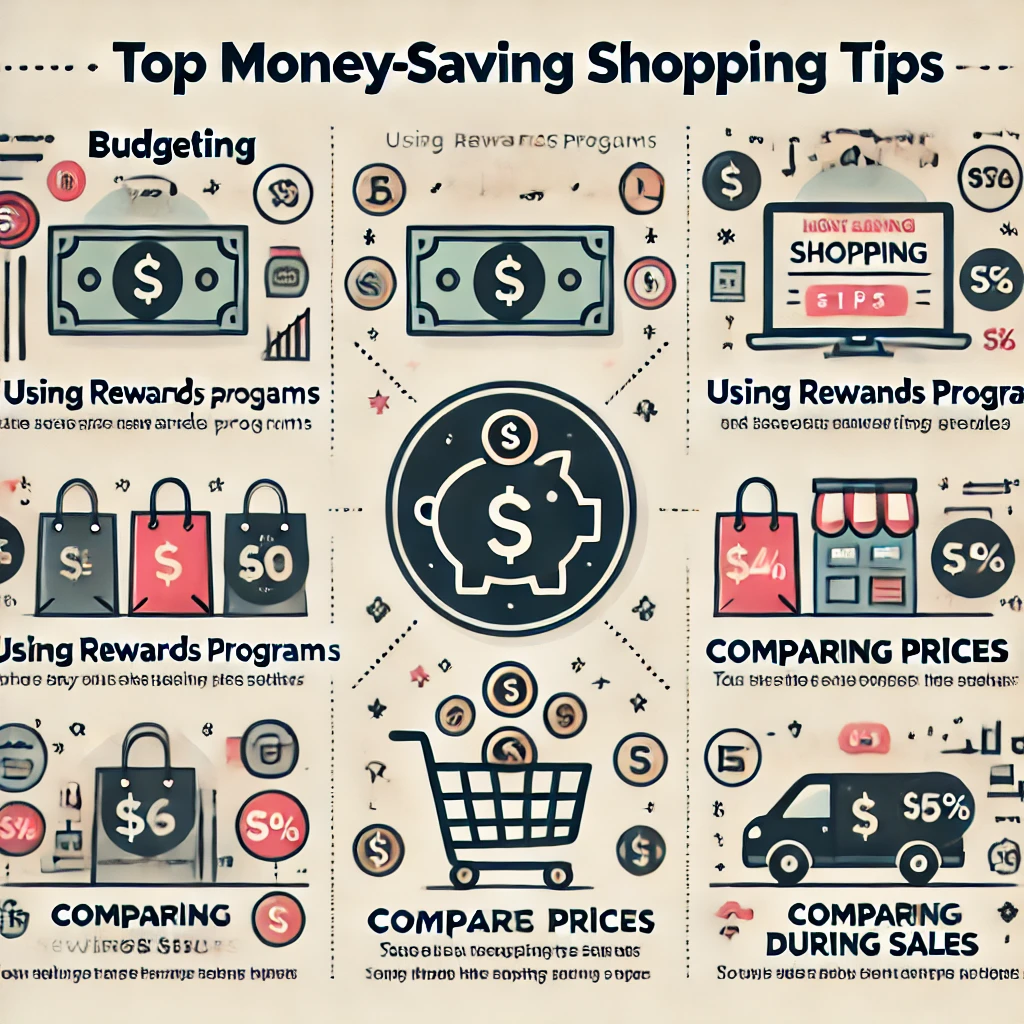Smart Consumer Finance: Tips for Better Shopping and Saving
 In the modern world, consumer finance and shopping are closely linked. With so many options and constant changes in pricing, it's more important than ever to shop smartly and manage your finances wisely. By understanding how to make strategic purchasing decisions, avoid common pitfalls, and leverage the right tools, you can save money, avoid debt, and make better financial choices. This article will cover essential tips on budgeting for shopping, making informed purchasing decisions, and leveraging rewards and discounts to maximize your shopping strategy.
In the modern world, consumer finance and shopping are closely linked. With so many options and constant changes in pricing, it's more important than ever to shop smartly and manage your finances wisely. By understanding how to make strategic purchasing decisions, avoid common pitfalls, and leverage the right tools, you can save money, avoid debt, and make better financial choices. This article will cover essential tips on budgeting for shopping, making informed purchasing decisions, and leveraging rewards and discounts to maximize your shopping strategy.
1. Setting a Shopping Budget and Sticking to It
Creating a budget for shopping is the first and most important step toward healthy consumer finance habits. This budget should be realistic, flexible, and in line with your overall financial goals.
Why a Shopping Budget Matters
A shopping budget helps you avoid impulse purchases and overspending, which are common reasons why people fall into debt. By setting spending limits, you prioritize your needs over wants and ensure that you don’t deplete funds meant for essentials, savings, or investments.
Steps to Create a Shopping Budget
- Track Your Expenses: Start by analyzing your current spending habits. Keep track of your purchases over a few weeks or a month, noting both necessary and discretionary expenses.
- Categorize Your Spending: Divide your expenses into categories like groceries, clothing, entertainment, and personal items. This breakdown gives you insight into where you may be overspending.
- Set Limits: Based on your income, determine how much you can allocate toward each category while still meeting other financial goals. Avoid setting unrealistic limits; flexibility is key.
- Use Apps to Stay on Track: Budgeting apps like Mint, YNAB (You Need A Budget), or PocketGuard can help you manage your shopping budget in real time, offering insights and reminders to stay within your spending limits.
Avoiding Budget Pitfalls
Budgeting doesn’t have to be restrictive. Allow room for occasional splurges or “treat yourself” moments. However, ensure that these are intentional purchases rather than impulsive decisions.
2. Planning Purchases and Avoiding Impulse Buying
Impulse buying can throw even the best budget off track. It’s essential to have a strategy in place to help you make thoughtful, informed purchasing decisions.
The 24-Hour Rule for Impulse Buys
Before making a non-essential purchase, wait 24 hours to consider if it’s something you genuinely need or want. This brief pause often reduces the desire to buy, helping you avoid impulsive spending.
Make a Shopping List and Stick to It
One of the simplest but most effective tools for staying on budget is a shopping list. Make a list before any shopping trip, whether it’s for groceries or personal items, and stick to it. This helps you avoid being swayed by in-store promotions or attractive product displays.
Shopping During Sales – Smartly
Sales and discounts can lead to significant savings, but they can also encourage unnecessary purchases. When planning for sales, such as Black Friday or holiday discounts:
- Make a list of items you truly need.
- Set a spending limit to prevent overspending.
- Compare prices across different stores to ensure you’re getting the best deal.
3. Understanding Consumer Rights and Avoiding Scams
With the increase in online shopping, consumers are more vulnerable to scams and fraud. Understanding your rights as a consumer and being vigilant while shopping can save you money and protect you from financial losses.
Know Your Rights
Every consumer has basic rights, such as the right to a refund for faulty products and the right to accurate product information. Familiarize yourself with consumer rights, especially around returns, refunds, and product warranties, to ensure you’re treated fairly.
Identifying and Avoiding Scams
Online scams are a growing issue, with fraudsters using tactics like fake websites, phishing emails, and social media ads to deceive consumers. To avoid scams:
- Verify the legitimacy of a website before making a purchase.
- Check customer reviews and research the seller.
- Avoid clicking on links in unsolicited emails or messages.
4. Using Cash Back and Rewards Programs
Cash back and rewards programs are excellent tools to help you save money and get extra value from your purchases. From credit card points to retail loyalty programs, these programs can make a noticeable difference in your finances when used wisely.
Choosing the Right Rewards Card
If you frequently use a credit card for shopping, consider a card with cash back or rewards for purchases in your most common spending categories (e.g., groceries, travel, dining). Some cards offer flat-rate cash back, while others offer higher rewards in specific categories. Just be sure to pay your balance in full each month to avoid interest charges.
Using Retail Loyalty Programs
Many retailers offer loyalty programs that provide discounts, special offers, or points toward future purchases. Sign up for these programs at your favorite stores, and watch for bonus points or rewards events. Remember to redeem points before they expire to maximize your savings.
Leveraging Cash Back Websites and Apps
Websites like Rakuten and Honey offer cash back on purchases made through their links. Simply create an account, browse stores on their platform, and activate cash back before buying. Additionally, apps like Dosh and Ibotta provide cash back for shopping at partner stores, giving you extra savings on top of any store promotions.
5. Mastering the Art of Comparison Shopping
Comparing prices across different stores or websites can lead to significant savings, especially for larger purchases. Thanks to the internet, comparison shopping is easier than ever.
Use Price Comparison Websites
Price comparison sites like Google Shopping, Shopzilla, and PriceGrabber allow you to see product prices across multiple stores at a glance. This ensures you’re getting the best possible price without manually checking each retailer.
Look for Price Match Policies
Many retailers, especially larger stores, offer price matching. This means they’ll match the price of an item if you find it cheaper at a competitor. Always carry proof (a screenshot or printed ad) and ask the retailer if they’ll match the lower price before purchasing.
Monitor Price Trends
For big purchases, such as electronics or appliances, monitoring price trends can help you find the best time to buy. Use tools like CamelCamelCamel, which tracks Amazon prices over time, or sign up for price alerts on items you’re interested in. Knowing price trends helps you avoid overpaying and recognize a genuine deal.
6. Smart Strategies for Grocery Shopping
Groceries are a regular expense, so learning to shop smartly in this category can make a noticeable difference in your monthly budget.
Plan Meals and Make a List
Meal planning is a powerful tool to reduce food waste and cut down on unnecessary spending. By planning your meals for the week, you’ll know exactly what ingredients you need, avoiding impulse buys or duplicate purchases. Stick to your grocery list to avoid overbuying.
Buy in Bulk (When Practical)
For non-perishable items or items you use frequently, buying in bulk can lead to significant savings. However, avoid bulk purchases for perishable goods unless you’re sure they’ll be used before they expire.
Use Coupons and Store Apps
Digital coupons and store apps can save you a few dollars here and there, which adds up over time. Many grocery stores have loyalty apps that offer personalized deals, and there are also websites like Coupons.com for printable grocery coupons.
Shop Store Brands
Store brands often offer the same quality as name-brand products but at a lower price. Try store brands for staple items like pasta, canned goods, and household supplies. You’ll often find there’s no noticeable difference except in price.
7. Minimizing the Financial Impact of Big Purchases
Large purchases, such as furniture, appliances, or electronics, can significantly impact your budget. Careful planning and smart shopping can help reduce these costs.
Avoid Financing Unless Absolutely Necessary
Many retailers offer financing options, but these often come with high interest rates. If you must finance a big purchase, look for no-interest offers and aim to pay it off within the promotional period.
Buy Refurbished or Used
Consider buying refurbished electronics, certified pre-owned items, or used furniture. Many refurbished items are like-new but at a fraction of the cost. Just be sure to check the warranty and return policy.
Take Advantage of Seasonal Sales
Certain times of the year are better for specific purchases. For example, appliances are often on sale during holiday weekends, while TVs tend to be discounted in January and February. Research the best time to buy the items you need, and plan your purchase around sales events to save money.
By incorporating smart consumer finance and shopping strategies, you can make the most of your income, avoid debt, and build a healthier financial future. From setting a shopping budget and avoiding impulse purchases to leveraging rewards programs and mastering price comparisons, these strategies empower you to take control of your finances while still enjoying the benefits of shopping. The key is to stay mindful, informed, and strategic in every purchase, ensuring that your shopping habits align with your financial goals.
